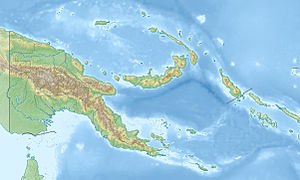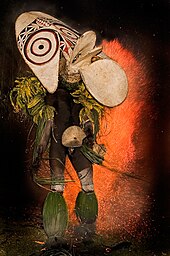New Britain
| New Britain | ||
|---|---|---|
| New Britain from Space (June 2005). The ash clouds from the Langila and Ulawun volcanoes are clearly visible | ||
| Waters | Bismarcksee | |
| Archipelago | Bismarck Archipelago | |
| Geographical location | 6 ° S , 151 ° E | |
|
|
||
| length | 520 km | |
| width | 146 km | |
| surface | 36,520 km² | |
| Highest elevation |
Ulawun 2334 m |
|
| Residents | 501,000 14 inhabitants / km² |
|
| main place | Kokopo | |
| Topography of New Britain | ||
The island of New Britain (English New Britain ; formerly Neupommern ) is located in the Bismarck Archipelago , is part of Melanesia and politically belongs to Papua New Guinea ; before 1885 the whole archipelago was called the New Britain Archipelago . New Britain is around 36,520 km² and in 2000 had around 400,000 inhabitants.
population
The Papuans are the oldest ethnic group on the island. The closest immigrants in time came from Melanesia .
The most important and largest group of people in New Britain are the Tolai . The Baining from the highlands have gained some notoriety with their ritual fire dance and penis stick. In addition, the Kilenge (on the coast), the Sulka (south of the Gazelle Peninsula ) and the Lakalai settle in New Britain between the coast and the mountains.
geography
With a length of about 520 km and a width of 29 km to a maximum of 146 km, it is the largest island in the Bismarck Archipelago . The greatest distance (as the crow flies) from the easternmost point to the westernmost point is 477 km. Since 1966, New Britain has been divided into two administrative districts, the provinces of East New Britain and West New Britain , with East New Britain being slightly smaller, but exceeding the province of West New Britain in terms of population and importance.
The capital of West New Britain is Kimbe with a population of 24,000. The largest town and capital of the province of East New Britain was Rabaul - until the eruption of the Tavurvur volcano in 1994 buried the city under its ashes (five dead). Most of the residents fled to Kokopo (formerly Herbertshöhe and the seat of the German colonial administration ), settled there and subsequently Kokopo became the provincial capital, as the place offered more security due to its protected location and already had an urban infrastructure .
The island runs through a high, rugged mountain range with the still active volcano Mt. Sinewit as the highest point (2438 m). A special volcanic landscape with sensitive ecological regions in the country and in the coastal area is located on the Willaumez peninsula . Most of the island is covered with rainforests .
history
From a European point of view, New Britain was only discovered by William Dampier on February 27, 1700 . From 1885 it was part of the German colonies under the name Neupommern, named after the Prussian province of Pomerania . Initially owned by the New Guinea Company , it belonged to the German New Guinea colony from 1899 to 1914 . In 1888 the administration was transferred to the island of Kerawara, which belongs to Neulauenburg (today's Duke of York Islands ) and in 1890 to Herbertshöhe (today Kokopo ) near Ralum in Neupommern, where it was continued by the German Empire from 1899 . During the time of the German administration, the cultivation of long-spiked cotton began. In addition, the Sacred Heart Missionaries tried to convert the population to Christianity, with "the low level of culture, polygamy and man-eating" viewed as obstacles.
In September 1914, the island was captured by Australian troops who fought a short battle with German and Melanesian forces in the battle near Bita Paka . After the First World War , New Britain was administered as a mandate of the League of Nations of Australia.
During the Pacific War , the troops of the Japanese Empire captured the port city of Rabaul on February 23, 1942 (→ Battle of Rabaul (1942) ) and on April 8, a unit landed in western New Britain. On December 15, 1943, the American troops landed at Cape Gloucester in northwest New Britain (→ Operation Dexterity ) and at Cape Merkus (German until 1918: Southern Cape ) in the southwest. Despite heavy bombing, Rabaul was only returned after the Japanese surrender in 1945 .
See also
- Battle of Arawe (1943–1944 in the Pacific War)
- West New Britain Province + East New Britain Province + Neuirland (eastern neighbor island New Ireland, formerly Neumecklenburg)
- List of German names for Papua New Guinea places
- List of provinces of Papua New Guinea
literature
- Hermann J. Hiery (Ed.): The German South Sea 1884-1914. A manual. 2nd, revised edition. Schöningh, Paderborn u. a. 2002, ISBN 3-506-73912-3 (review by Gerhard Krebs, University of Hamburg: PDF file, 15 kB; 3 pages ).
- Hans-Joachim Hoeveller: Neupommern - A lost and forgotten country. In: Pomerania - magazine for culture and history. Volume XXXIX, Issue 3, 2001, pp. 4-6.
Dietrich Neumann: Neupommern - A lost and forgotten country. Complement. In Pomerania - magazine for culture and history. Volume XL, Issue 4, 2002, pp. 42–43. ISSN 0032-4167 - Lutz Mohr : pioneer of the South Seas. Georg von Schleinitz (1834–1910) - commander, marine researcher, circumnavigator and honorary doctorate from the University of Greifswald. In: The Pommersche Zeitung . Volume 64, episode 46 from November 15, 2014.
- Max H. Rehbein : "Where will I go, sir?" New Britain. In: Same: Pioneers and Adventurers. Buch und Zeit (license Olde Hansen, Hamburg), Cologne 1970, pp. 10–47 (1968 tour in south-north direction across the island, with a detailed map).
Web links
Individual evidence
-
↑ a b
Lexicon entry: Neupommern. In: Heinrich Schnee (Hrsg.): Deutsches Kolonial-Lexikon , Volume 2, Quelle and Meyer, Leipzig 1920, p. 638 ff.
Quote: "Neupommern is the largest island of the Bismarck Archipelago belonging to German New Guinea (approx. 34,000 square kilometers) […] It was discovered by Dampier in 1700 and called New Britain, as it is still called in English and French scriptures; For a time in the 19th century the name Birara was common, but it actually only refers to a small area of the island, and in 1885 the island was taken over by the German commissioner v. Örtzen renamed Neupommern. " -
↑
See the Ethnologue entry for the Kilenge language : Maleu-Kilenge: A language of Papua New Guinea. (English) In: M. Paul Lewis u. a. (Ed.): Ethnologue: Languages of the World. 17th Edition, SIL International, Dallas Texas 2013. Retrieved August 1, 2013. Citation: “Population: 5,200 (1983 census). 1,560 kilograms. Location: West New Britain Province, Talasea district west tip. "
-
↑
See the Ethnologue entry for Sulka language : Sulka: A language of Papua New Guinea. (English) In: M. Paul Lewis u. a. (Ed.): Ethnologue: Languages of the World. 17th Edition, SIL International, Dallas Texas 2013. Retrieved August 1, 2013. Citation: “Population: 2,500 (1991 SIL). Location: East New Britain Province, East Pomio district, Wide Bay coast. "
-
↑
See on the Lakalai people: Ann Chowning: Lakalai. (English) In: Countries and Their Cultures. 1997 (?). Retrieved on August 1, 2013.
Quotation: “Lakalai - Orientation: […] Location: The Lakalai are distinguished from speakers of related dialects and languages, all labeled Nakanai, by the absence of the phonemes in their language. [...] they often identify themselves to outsiders simply as West Nakanai. [...] Lakalai villages are on the central and eastern part of the Hoskins Peninsula on the island of New Britain. [...] The population increased from under 2,700 in 1954 to almost 6,500 in 1980. The expansion reflects recovery from depopulation occasioned by Japanese occupation during World War II, coupled with the abolition of warfare and access to Western medicine. [...] Lakalai is an Oceanic (Austronesian) language, the westernmost of a chain of dialects also spoken in Ubae, in the West Nakanai Census Division, and in coastal villages of Central Nakanai Census Division, to the east. [...] Lakalai - Kinship - Kin Groups and Descent: Every Lakalai is born into a named, nonlocalized, agamous matrilineal descent group [...] ".
Info: Chowning, English professor of anthropology, is a recognized expert on the Lakalai people and provides a detailed ethno-sociological overview (probably created in 1997). -
↑
Isimel Puipui: Kokopo Urban Local Level Government. ( Memento of the original from April 4, 2011 in the Internet Archive ) Info: The archive link was inserted automatically and has not yet been checked. Please check the original and archive link according to the instructions and then remove this notice. (PDF; 1 MB; English; 7 pages with maps) Local Government Managers Australia, South Melbourne, Australia [undated], p. 2. Retrieved on August 1, 2013. Quotation: “After the devastation of Rabaul Township by the volcano in 1994, the obvious choice for the alternative government center was Kokopo; because of two reasons. Firstly, it offers a safe location from future threats from the volcano and secondly, that Kokopo already had the urban infrastructure to accommodate people in cases of emergencies. " Info: Puipui is Town Manager of the New British city of Kokopo.
-
↑
Lexicon entry: Neupommern, Catholic Mission (Apostolic Vicariate). In: Heinrich Schnee (Hrsg.): Deutsches Kolonial-Lexikon , Volume 2, Quelle and Meyer, Leipzig 1920, p. 638 ff.
Quote: “The Bismarck Archipelago was already entrusted to the Marists as part of the South Sea area in 1844 for the mission work, but could only since 1881 by the missionaries of St. Heart of Jesus (sd) to be tackled. In 1890 the Vicariate of Neupommern was established. Bishop Couppé had almost no success with his missionaries until 1894; the low level of civilization, polygamy and cannibalism were too great obstacles. From 1894 onwards the mission took an unexpected boom […] The mission is thus far superior to the evangelical one (from Australia). "




